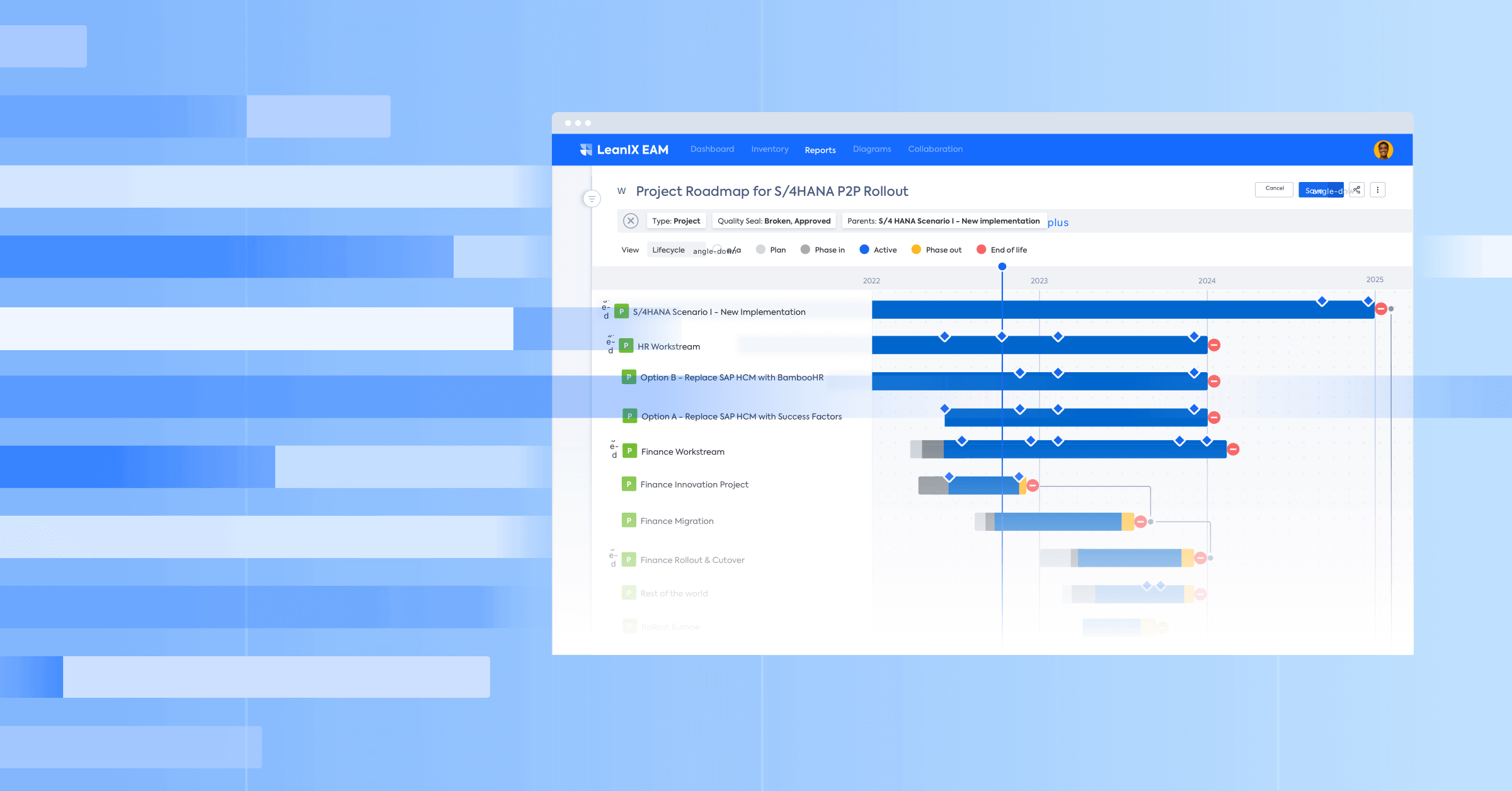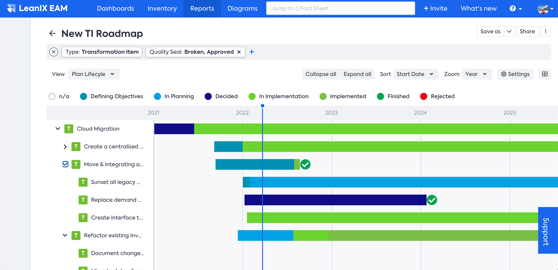
Digital transformation roadmaps (or, as we like to think of them, continuous transformation roadmaps) are vital for keeping your organization competitive. Let's explore why roadmapping is critical for success and cover eight actionable steps you can take to create your roadmap.
Why digital transformations fail
Continuous transformation is an undeniable imperative in today’s business world, but McKinsey reports that a staggering 70% of attempted digital transformations fail. There are many reasons behind these failures, including:
- a lack of skills in needed areas
- failure to get buy-in from employee and leadership groups
- no cadence for meetings to oversee projects
- a lack of change management infrastructure
- irregular performance management discussions
A digital transformation roadmap is the key to surpassing these challenges. A roadmap helps leaders break down a transformation initiative by its individual components. They can then organize these components in a cohesive way that’s both understandable and approachable for everyone involved.
In this article, we’ll walk through eight proven steps you can implement to build a roadmap that aligns with your goals and supports your digital transformation. First, however, let's consider what a roadmap is and why it's so important.
Digital transformation roadmaps: A quick recap
As we said above, a digital transformation roadmap is a visual document that outlines the continuous transformation journey from your company’s current state to its target state and beyond. It documents the tools, tasks, and people needed to move your transformation forward.
Here's what a roadmap looks like in the LeanIX platform:
Jason Porterfield, SAP’s VP for Enterprise Architecture, gave a presentation on roadmaps at last summer’s LeanIX Connect Summit. He emphasized a few key points on building roadmaps:
- no business sits still, so your digital transformation roadmap should be a living document aimed at continuous transformation
- companies must understand their current state before they can successfully transform
- leadership and stakeholder buy-in is essential and roadmaps help to build it
- storytelling documents like capability models and action plans support you in the execution of roadmaps
1. Know where you stand
You can’t know how your organization needs to transform without first understanding its current state. Your current state architecture — a visual representation of every component of your IT infrastructure and the relationships between them — is a powerful tool for building this critical knowledge.
Take Marc O'Polo, for example. The German fashion and retail brand accelerated its SAP S/4HANA transformation by using LeanIX to accurately map the current state of its IT infrastructure before moving forward.
Developing a view of your current state architecture, ideally with the help of an EAM platform, will help you set goals (more on those later) and decide how to prioritize the various projects on your digital transformation roadmap.
2. Build your team
Who will be involved in building your digital transformation roadmap? Every business unit is affected in one way or another by continuous digital transformation. Stakeholders from across the business should be included on your planning team.
That said, not everyone has to be involved in the same way or at the same level. Some will be leaders; others will be as-needed strategic contributors or provide technical execution support.
The key is to identify who will be involved, define their roles, and get everyone on board before you actually begin the process.
3. Identify goals and KPIs
How will you measure progress? Continuous transformation should have clearly defined key performance indicators (KPIs) and a digital transformation roadmap that benchmarks actions for achieving them.
Start by setting goals with your team using proven frameworks like SMART, CLEAR, or OKRs. Expand on those to find the right KPIs and metrics for measuring your progress.
Utilize timeline features on your roadmap to show exactly when goals should be accomplished and what benchmarks should be achieved.
4. Create your digital transformation roadmap
Once you’ve outlined your current state, assembled your team, and defined your goals, it’s time to actually build your digital transformation roadmap.
As Jason Porterfield outlined in detail during his LeanIX Connect Summit talk: You should focus on finding a template that aligns with your needs and resonates with key stakeholders, then execute against it using best practices and standards.
As long as you have the information you need in your roadmap and stick to its execution, you’ll be positioned to succeed. Some best practices for your roadmap include:
- Make it visual — it should tell a story and show your transformation journey in a snapshot
- Be detailed — maintain accountability by not leaving out the specifics, especially concerning timelines and persons responsible
- Make it shareable — your roadmap should live in a shared digital environment where it can be viewed and used by various stakeholders
Thankfully, the LeanIX platform empowers you to automate and crowdsource this process. Building a detailed, visual model in a location accessible to everyone in your organization will make continuous transformation seem simple.
5. Getting stakeholder buy-in for your digital transformation roadmap
Transformation isn’t possible without buy-in, and getting it can be complicated. People in different roles and at different levels in the organization can have tunnel vision around things like cost savings or maintaining legacy systems that support "the way things have always been."
Sometimes people may not see the value in digital transformation, seeing it as little more than change for change's sake. Helping them adjust their outlook requires emphasizing the concrete business value planned changes will bring.
For example, when a new tool comes with a hefty price tag, be ready to outline all the ways it will enhance business results (Will it create efficiencies and cost savings? Help convert more sales? Emphasize this!). If it’s time to migrate to a new system, focus on the new capabilities and benefits that will come along with it.
Your digital transformation roadmap goes a long way during this step. It provides a visual picture of how change will take place and what your organization will look like when it’s complete (your target state). Roadmaps make your plan compelling and turn what could be a seemingly complex strategy into a centralized, digestible, organized plan.
6. Invest in a platform solution
We talked about centralized visibility for your digital transformation roadmap, and the right tool deliver that.
An EAM platform like LeanIX will not only provide tools for building roadmaps, but also a shared and accessible place for your team to view, edit, and refer back to your roadmap as needed while your continuous transformation progresses.
Rather than holding excessive meetings or (worse) always feeling a step behind, team members can see real-time updates and take action accordingly when your digital transformation plan calls for it.
7. Build culture around change
Change can be challenging, no matter how valuable it will prove to be in the long run. This is especially the case in large organizations where employee enthusiasm might vary. Taking time to build a culture of continuous transformation is critical for success.
Building culture starts with educating members of your organization about the purpose of transformation, and how it will impact them individually and collectively. Your digital transformation roadmap can be helpful here, too, although you likely won’t want to overwhelm people with your fully detailed version.
Instead, a simplified version that focuses less on execution steps and more on benefits can help employees understand why digital transformation needs to take place.
8. Measure and adjust
Remember Jason’s apt advice mentioned earlier: No business sits still, and neither should your roadmap.
Your digital transformation roadmap should be a living document that you adjust as needed as you work through continuous transformation. Monitor your progress closely and be sure your roadmap reflects the current status of your initiative while also maintaining your originally outlined plan.
Time to start your own digital transformation roadmap
A digital transformation roadmap is powered by the right tools, and LeanIX’s EAM platform was built to help organizations transform.
Our solution helps clients leverage technology, make decisions, and manage change with an outcome-driven approach. LeanIX's flexible, best practice data model provides the foundation for meeting all business needs.
To find out more about how LeanIX can support your digital transformation roadmapping, book a demo today.






